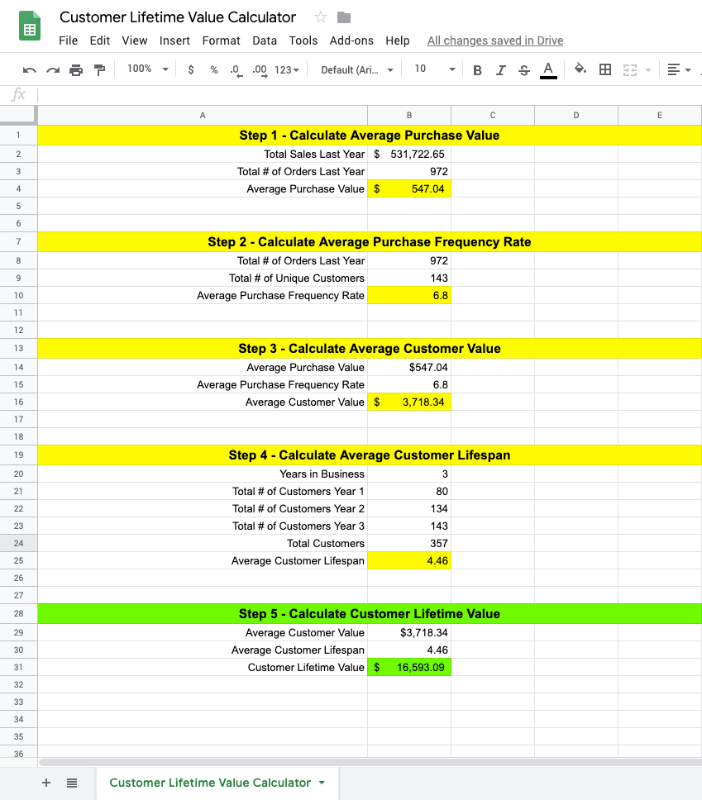How much is a customer worth to you? Most people would say “everything”, and be 100% correct. But still, there is a way for you to calculate what a typical customer for your shop is worth.
Do you know how to do this?
No?
That’s ok. I’m going to walk you through it step by step using an example shop’s math.
If you want to play along, here’s a handy Lifetime Customer Value calculator that you can use. Replace my example numbers with your own.

Here are the things that we need to assess:
Calculate the Average Purchase Value
What is the average dollar amount per order for your business?
To calculate this average use last year’s numbers and divide the total top-line sales amount by the number of orders placed. For our example shop, they had $531,722.65 in sales last year. There were 972 orders.
$531,722.65 divided by 972 orders = $547.04

Calculate the Average Purchase Frequency Rate
How frequent are your customers ordering from you?
To calculate this average use last year’s numbers and divide the total number of orders placed by the number of unique customers that placed the orders. For our example shop, they had 972 orders that were placed by 143 different customers.
972 orders placed by 143 unique customers = 6.8

Calculate Average Customer Value
What is an average customer worth?
To calculate this, we’ll use the Average Purchase Value x the Average Purchase Frequency Rate.
With our example numbers that’s $547.04 x 6.8 = $3,718.34

Calculate Average Customer Lifespan
How long do your customers continue to do business with your shop?
This is difficult, especially if you haven’t been in business long. One method is to use is your churn rate.
To get that number, take the total number of unique customers from each year you have been in business and divide by the number of customers in the first year.
So, in our example shop, they have been in business for three years. Year 1 had 80 unique customers. Year 2 saw 134. Year 3 was 143. The sum of all of those years is 357.
Divide the sum 357 by the total amount of unique customers in Year 1, which was 80, and that means the Average Customer Lifespan is 4.46.

Calculate Customer’s Lifetime Value
Using the numbers we’ve built, we can calculate the shop’s Customer Lifetime Value. To do this, we take the Average Customer Value ($3,718.34) and multiply by the Average Customer Lifespan (4.46).
$3,718.34 x 4.46 = $16,593.09

Why Is This Important?
For starters, it is important as shops need to do a better job of wrapping their head around the idea of how much a customer is worth for years down the road. I think people in this industry tend to only focus on the order at hand, and not the monetary value of the customer to the business.
That isn’t a $547.04 customer, but a $16,593.09 one. Of course, this is example math. Yours will be different. But the mindset is still the same.
Customer Lifetime Value is a great metric to use as it can predict what your shop can expect to see from a revenue standpoint for each customer if you keep them happy.
143 satisfied customers that spend $16,593.09 each can potentially bring $2,372,811.87 in revenue to the business.
What’s your math look like? You won’t know unless you do the homework.
Build a Better Relationship
This is why spending the effort building a better relationship with your customers is so crucial. Most business owners know that it is easier to retain a customer than acquire a new one.
So do you have a plan in place for that?
Are you educating, nurturing, and spending money on your customers to keep them happy? This has to be an on-purpose effort.
If your shop operates with the idea that you are simply a bunch of order takers and don’t do much to cultivate a valuable relationship with your customers, don’t be surprised when they go somewhere else. Remember this: in order to start using another shop, your current customers are going to have to fire you.
Are you giving them a reason?
Improving Customer Lifetime Value
So the big question on your brain right now maybe “how do you get these metrics to increase?” We all want to improve, right?
Here are a few ideas for you to use:
Be a Problem Solver
First, stop selling ink or thread on fabric. That’s not what you do.
Ask more questions. Get to the root of the problem for your customer. What is the source of the issue they are facing?
- It’s a family reunion order. Nobody wants to be the money taker and be stiffed by their weird cousin Fred for the shirts. Your value is to set up a website ordering platform to take the orders, collect the money, and help them make the event a success. You’ll even ship everyone their shirts so nobody has to spend time handing them out.
- It’s a company uniform program. This isn’t about simply decorating a shirt with their logo, this is about connecting what the company wants its customers to feel when they see someone wearing the garment. There are a lot of choices that can impact that. Your job is to guide that company to make better overall choices to accomplish that mission.
- It’s a rock band. They potentially can make more money from their merchandise than from playing a show. How are you helping with that? What happens when they run out of a particular size next week while on tour, can you show them your process for resupplying them so they can make those sales?
Want more to increase your Customer Lifetime Value? Be continually digging in and finding what the customer’s challenge is and how you can solve it.
This is your opportunity.
Invest in Customer Satisfaction
Happy customers stay where they are. When problems come up, as they are sure to do on occasion, this is your opportunity to demonstrate how much their business means to you.
Will you do what it takes to resolve the problem so they actually think better of your shop than before? One way is to give your sales or customer service reps a budget to use to solve these challenges without asking for permission. $250 or $500 can go a long way to immediately help out a situation. That could be upgrading the freight or ordering a few more shirts.
Think in terms of the Customer Lifetime Value, not in terms of how much that order total might be.
Can you make magic happen and put a smile on someone’s face?
Most customers don’t really remember everything you do for them, but they can talk hours on end about the last crappy thing that happened when dealing with your company.
It’s in this circumstance that you solidify that relationship. Or not.
Think About Loyal Relationships
Check out this fantastic report from Bain & Company called, “Prescription for Cutting Costs”. There are a few stories in this article that I think are worth a closer look when we think about the concept of customer retention.
The first being the fact that you need to be servicing the right kind of customers. Loyal relationships start by identifying who are the right kinds of customers for your shop. If you want to increase the Customer Lifetime Value rate, the best place to start is focusing on better customers.
Here’s a great quote that ended the article, “No company is immune to the pressure of the market. But companies that focus on building loyal relationships that by their very nature keep costs to a minimum are far better positioned to remain strong in the face of market turbulence.”
Better customers = a stronger company. That’s your shop we’re talking about here.
Don’t take “any job that walks through the door”. Be selective. Think about who is a good fit for your shop then go after them.
Be purposeful. Find better customers.
“Too many people today know the price of everything and the value of nothing.” – Ann Landers
“The Golden Rule for every businessman is this “Put yourself in your customer’s place.” – Orison Swett Marden
“Customer loyalty comes from consistent experience. They learn to count on you.” – Jimmy John Liautaud





